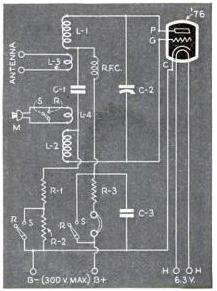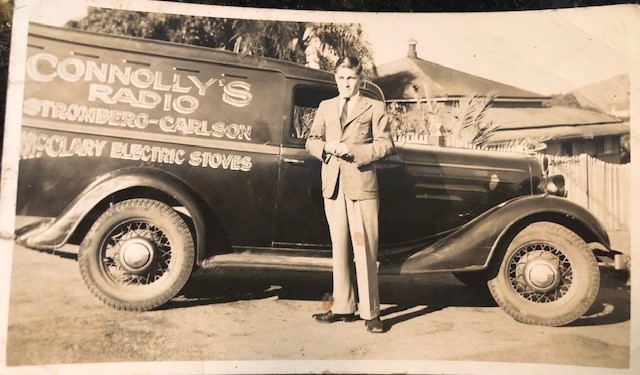I received an interesting e-mail from Bob Miller, the nephew of the gentleman shown above, Jim Pearson of Townsville, Queensland, Australia. As you can see from the truck, he worked in the 1930s as a radio serviceman for Connolly’s Radio. According to this 1945 ad, the company was located at 128 Flinders Street.
According to the truck, the company sold Stromberg-Carlson radios. The American company started its Australian subsidiary in 1927 by importing American sets. But the subsidiary, Stromberg-Carlson (Australasia) Pty. Ltd., was autonomous, and soon began manufacturing its own sets for the Australian market. The McClary Electric Stoves advertised on the truck were possibly similar to this one. Stoves by that name were also made in Canada.
 Pearson was killed in action in RAF Bomber Command in 1942. The reason I was contacted is the schematic shown at left, which was found in Pearson’s effects. For a larger version, from most browsers, click twice on the image. Miller correctly guessed, probably from the presence of both a microphone and headphone, that the circuit was for a transceiver.
Pearson was killed in action in RAF Bomber Command in 1942. The reason I was contacted is the schematic shown at left, which was found in Pearson’s effects. For a larger version, from most browsers, click twice on the image. Miller correctly guessed, probably from the presence of both a microphone and headphone, that the circuit was for a transceiver.
The size of the main coils is specified as 5 turns, a half inch long, with an inside diameter of a half inch. This led me to believe that it was for VHF, either 5 meters or 2-1/2 meters. We’ve previously shown similar circuits for amateur and WERS transceivers, such as this one, this one, and this one. Some of those circuits have two tubes, the second one being an audio stage used both transmitting and receiving. But they all employed the same simple idea–a single tube is used for a transmitter, and by switching a few components around, as a superregenerative receiver.
 But something looked very familiar about this particular version. I did a little more digging, and realized that we had previously shown an identical circuit, the schematic shown here. The circuit was the design of Stanley Johnson, W9LBV (later W0LBV), of Grand Island, Nebraska, and appeared in the December 1935 issue of Popular Science.
But something looked very familiar about this particular version. I did a little more digging, and realized that we had previously shown an identical circuit, the schematic shown here. The circuit was the design of Stanley Johnson, W9LBV (later W0LBV), of Grand Island, Nebraska, and appeared in the December 1935 issue of Popular Science.
The diagrams and parts specifications for the two sets are virtually identical, so the Pearson drawing must have originated with the Popular Science article. The only difference is that the article uses a type 76 tube, but Pearson’s diagram calls for either a 56 or a 76. The two tubes appear to be identical, with only the filament voltage being different. Perhaps the 56 was easier to find in Australia.
Johnson, the American author, went on to write a number of other construction articles over the years, such as a novice transmitter in the October 1951 issue of Popular Mechanics. He died in 2003.
Miller didn’t know whether Pearson ever got his ham ticket or if he ever built the radio. I checked the 1938 callbook listings for Queensland, and didn’t see any listing under his name. Perhaps he was licensed elsewhere, or perhaps he planned on getting his ticket after the War. That, of course, never happened, as his life was cut short by the War.
One of the reasons why Amateur Radio exists is because of its ability to promote international goodwill. And I find it remarkable that a design by a young man in Nebraska, USA, made its way to another young man in Queensland, Australia, long before the Internet made such a thing commonplace. Maybe Pearson or one of his friends subscribed to the American magazine. But more likely, some American ham was talking with an Australian ham about his new five-meter rig, sent a copy of the diagram, and the diagram made its way, via the grapevine, to a young man in Queensland who decided to give it a try.

